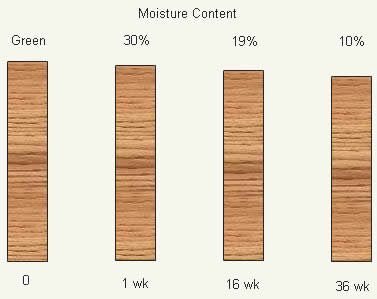Problem: Dimensional changes.
Cause: Swelling and shrinkage as moisture enters and leaves the wood.
When wood is dried from the fiber saturation point to 19% average moisture content, lumber shrinks about 2.35% in width. On a board measuring 9 1/2 inches (235 mm) wide, this would result in shrinkage of 1/4 inch (6 mm). As lumber continues to dry to 7 to 10%, some further shrinkage will occur, most noticeably at floor headers as shown in Figure 2.

Figure 2 - Shrinkage versus Moisture Content For Kiln-Dried Lumber
Drying has little effect on the length of the lumber. However, as the wood dries out, internal stresses are created. These stresses can result in the wood's bowing (crowning), crooking, twisting, or cupping as shown below; Figures 3a, 3b, 3c and 3d.
Internal Stresses In Wood (Lumber)

Figure 3a - Bow

Figure 3b - Cup
Figure 3c - Twist
Figure 3d - Crook
Solutions:
- Schedule lumber deliveries to minimize the time lumber is stored on site.
- Keep lumber off the ground, away from free-standing water, snow or curing concrete slabs.
- Maintain wrappings on lumber for as long as possible, or cover lumber with a tarpaulin to protect it from rain and snow.
- Store the lumber flat, with sufficient supports; wood tends to take a permanent set when deformed for long periods of time.
- Promote ventilation of piles of lumber by keeping piles separated with spacers between lumber layers.
- Restrain thin or long pieces of wood in piles by packaging these or weighting them down; thin pieces will deform more than thick pieces, and long pieces are more likely to deform than short pieces.
- If wood must be stored on end, provide sufficient supports and rotate the pieces end-over-end periodically.
